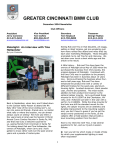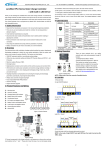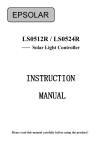Download USER MANUAL
Transcript
EPSOLAR LS1024BP/ LS2024BP ——Solar Charge Controller USER MANUAL Thank you very much for selecting our product! This manual offers important information and suggestions with respect to installation, use and troubleshooting, etc. Please read this manual carefully before using the product and pay attention to the safety recommendations in it. LandStar LS1024BP/ LS2024BP ——Solar Charge Controller Nominal system voltage 12 / 24VDC* Maximum PV input voltage 50V Nominal charge / discharge current LS1024BP 10A LS2024BP 20A *The solar charge controller has the system voltage 12/24V automatic recognition function and custom define function, and all charge, discharge and load control parameters can be modified. Warranty: The charge controller is warranted to be free from defects for a period of two years from the date of shipment to the original end user. Notice: Manufacture is not responsible for the damage of any part of controller due to operator's misuse, battery parameters mismatch, unreasonable system configuration, unauthorized repairment or exceeding the specified parameter. Contents 1 Important Safety Information..................................1 2 General Information ................................................1 3 Installation Instructions ...........................................2 3.1 General Installation Notes ........................2 3.2 Wiring..........................................................3 4 Operation ..................................................................4 4.1 LED Indicators ...........................................4 4.2 Setting Operation ......................................5 5 Protection, Troubleshooting ...................................6 5.1 Protection ...................................................6 5.2 Troubleshooting.........................................7 6Technical Specifications ..........................................9 1 Important Safety Information Please inspect the controller thoroughly after it is delivered. If any damage is seen, please notify the shipping company or our company immediately. 2 General Information LandStar BP series solar charge controller adopts the most advanced digital technique and operates fully automatically. It’s Ideal for extreme environments with corrosion, dust, water etc and has various unique functions: 12V/24V automatic identify or user-defined working voltage. High efficient Series PWM charging, increase the battery lifetime and improve the solar system performance. Use MOSFET as electronic switch, without any mechanical switch. Multiple load control modes, increase the flexibility of the load output Gel, Sealed, Flooded and user-defined battery type option. Adopt temperature compensation, correct the charging and discharging parameters automatically and improve the battery lifetime. New SOC method of calculating accurately displays the available battery capacity. LandStar BP has no keys , The control function and the switch condition of the load can be modified by communication connection. Electronic protection: Overheating, over charging, over discharging, overload, and short circuit. Reverse protection: any combination of solar module and battery. With functions of current power calculation and real-time energy statistics recording, it is convenient for users to view charging and discharging energy of each day, month, year and total value. Use of standard Modbus communication protocol for TTL-232 bus connections, communication protocol compatibility much better Support firmware upgrade 1 Fully encapsulated PCB, IP67 protection Aluminumhousing 3 Installation Instructions 3.1 General Installation Notes Be very careful when working with batteries. Wear eye protection. Have fresh water available to wash and clean any contact with battery acid. Never short circuit the battery positive and negative terminals and wires which may cause explosion or fire. Install external fuses/breakers as required. Disconnect the solar module and fuse/breakers near to battery before installing or adjusting the controller. Confirm that power connections are tightened to avoid excessive heating from loose connection. Uses insulated tools and avoid placing metal objects near the batteries. Explosive gasses may be present during charging. Be certain there is sufficient ventilation to release the gasses. Loose power connections and/or corroded wires may result in resistive connections that melt wire insulation, burn surrounding materials, or even cause fire. Ensure tight connections and use cable clamps to secure cables and prevent them from swaying in mobile applications. Only charge the batteries that comply with the parameters of controller. Battery connection may be wired to one battery or a bank of batteries. The following instructions refer to a singular battery, but it is implied that the battery connection can be made to either one battery or a group of batteries in a battery bank. 2 3.2 Wiring 1. Connect components to the charge controller in the sequence as shown above picture and pay much attention to the “+”(Red)and “-“(Black).Always power the battery First. 2. After power the battery, check the battery indicator on the controller, it will be green. If it’s not green, please refer to chapter 5. 3. The battery fuse should be installed as close to battery as possible. The suggested distance is within 150mm. 3 4 Operation 4.1LED Indicators Battery Status LED indicator Charging Status LED indicator Indicator Status Description Green On Solid Normal Slowly Green In charging Flashing Green OFF Green On Solid No charge Normal Slowly Green Full Flashing Green Fast Flashing Orange On Solid Under voltage Red On Solid Over discharged 4 Over voltage Battery over Red Flashing temperature Charging and battery indicator (red)flashing System voltage simultaneously error Charging and battery Controller indicator(orange)flashing overheating simultaneously 4.2Setting Operation Three methods to program the controller: 1–Remote Meter,MT50/MT100(Use dedicated TTL232 to RS485 communication cable with CC-TTL-RS485-200U). 2–Super Parameter Programmer, SPP-01(Use dedicated TTL232 to TTL232 communication cable with CC-TTL-TTL-150U). This method can realize one-key setting operation which is suitable for bulk quantity products setting or applied in the projects. 3–PC monitoring setting software “Solar Station Monitor” ( Use dedicated TTL232 to USB communication cable with CC-USB-TTL-150U). Through the remote meter and PC software, it can realize real-time monitoring, modification of control parameter, charge mode, load work mode, inquiry of failure information etc. 5 Note: Please refer to the user manual of MT, SPP-01 and PC software for more details. ·Load Set 1.Manual Control 2.Light ON/Off (default) 3.Light ON+ Timer 4.Time Control ·Battery Type 1.Gel 2.Sealed(default) 3.Flooded 4.User 5 Protection, Troubleshooting 5.1 Protection ·PV Array Short Circuit If PV array short circuit occurs, clear it to resume normal charge automatically. ·Load Overload If the load current exceeds the rated discharge current of controller (≥1.05 times rated discharge current), the controller will disconnect the load. Once the overload occurs, the way to solve is to send a “remote load switch” command or reset the controller after reducing the load. ·Load Short Circuit Fully protected against load wiring short-circuit(≥2 times rated discharge current). After one automatic load reconnect attempt, the fault must be cleared by restarting the controller or sending a “remote load switch” command. ·PV Reverse Polarity Fully protection against PV reverse polarity, no damage to the controller will result. Correct the miswire to resume normal operation. ·Battery Reverse Polarity Fully protection against battery reverse polarity, no damage to the controller will result. Correct the miswire to resume normal operation. 6 ·Battery working voltage error If battery voltage does not match controller working voltage, controller will stop working. After correcting the voltage, the fault must be cleared by restarting the controller or sending a “remote load switch” command. ·Damaged Temperature Sensor If the temperature sensor short-circuited or damaged, the controller will be charging or discharging at the default temperature 25℃ to prevent the battery damaged from overcharging or over discharged. ·Overheating Protection If the temperature of the controller heat sink exceeds 85C, the controller will automatically start the overheating protection and stop the charging and discharging. When the temperature is below 75℃, the controller will resume to work. ·High Voltage Transients PV is protected against smaller high voltage surge. In lightning prone areas, additional external suppression is recommended. Note: The controller has daily automatic fault recovery function which will reduce the manual operation and can intelligently eliminate the fault caused by non-actual hardware failure. 5.2 Troubleshooting Possible reasons Faults Troubleshooting Charging LED indicator off during daytime PV when sunshine array falls on PV disconnection Check that PV and battery wire connections are correct and tight. modules properly. 7 Battery voltage Green Battery higher than over LED indicator voltage fast flashing disconnect LED indicators orange over high, disconnect the solar module immediately and change a new controller. voltage(OVD) Battery Check the battery voltage. If it Load output is normal. Charging Battery under LED indicator will return to green voltage automatically when fully charged. Battery LED The controller cut off the output indicators RED Battery automatically. LED indicator will color and loads over discharged return to green automatically not working. when fully charged. Remove or cut out the additional Load abnormal shutdown load and sending a “remote load switch” Over load command , the controller will resume to work after 3s or restart the controller. Clear short circuit and sending a Load abnormal shutdown “remote load switch” command, Short circuit the controller will resume to work after 3s or restart the controller. When heat sink of the controller exceeds 85 ℃, the controller will All the led indicator Too high flashing temperature of (battery orange controller automatically cut input and output circuit. When the temperature below 75℃, the controller will resume to work. indicator Please reduce the environment flashing) temperature, the power of solar module or the power of the load. All the led indicator flashing (battery red Check whether the battery System voltage voltage match with the controller error working voltage. Please change to a suitable battery or reset the indicator working voltage. flashing) 8 Choose the SOC value incorrect wrong battery Correct the right battery type; type; Using the Using the configuration of the reconfigured charging voltage compensation if profile of the choosing the user defined battery user defined type and ignore the SOC battery type. 6Technical Specifications Electrical Parameters Description Parameter Nominal System Voltage 12 /24VDC Max. PV input voltage 50V Max. Battery Terminal Voltage 34V LS1024BP10A LS2024BP20A Rated Battery Current ≤0.28V Charge Circuit Voltage Drop ≤0.20V Discharge Circuit Voltage Drop ≤8.4mA/12V ≤7.8mA/24V Self-consumption Temperature compensation coefficient -3mV/℃/2V (Default) Grounding Positive grounding 9 Battery Voltage Parameters (parameters is in 12V system at 25℃, please use X 2 in 24V system) Control Parameters Battery charging Flooded User 16.0V 16.0V 9~17V 15.0V 15.0V 15.0V 9~17V 15.0V 15.0V; 15.0V 9~17V —— 14.6V 14.8V 9~17V 14.2V; 14.4V 14.6V 9~17V 13.8V; 13.8V; 13.8V 9~17V 13.2V; 13.2V 13.2V 9~17V 12.6V 12.6V 12.6V 9~17V 12.2V 12.2V 12.2V 9~17V 12.0V 12.0V 12.0V 9~17V 11.1V 11.1V 11.1V 9~17V 10.6V 10.6V 10.6V 9~17V Equalize Duration —— 2 hrs. 2 hrs. 0~3 hrs. Boost Duration 2 hrs. 2 hrs. 2 hrs. 0~3 hrs. setting Gel Sealed 16.0V Over Voltage Disconnect Voltage Charging Limit Voltage Over Voltage Reconnect Voltage Equalize Charging Voltage Boost Charging Voltage Float Charging Voltage Boost Reconnect Charging Voltage Low Voltage Reconnect Voltage Under Voltage Warning Reconnect Voltage Under Voltage Warning Voltage Low Voltage Disconnect Voltage Discharging Limit Voltage 10 Notes: 1.The default battery type is Sealed. For Gel, Sealed, Flooded battery type, the voltage point is fixed, unable to modify it. 2.User type is the user defined battery type. The default value is the same as sealed type. When modify it, please follow the below logistic relation: a ) Over Voltage Disconnect Voltage>Charging Limit Voltage≥ Equalize Charging Voltage ≥Boost Charging Voltage≥Float Charging Voltage >Boost Reconnect Charging Voltage; b ) Over Voltage Disconnect Voltage>Over Voltage Reconnect Voltage ; c) Low Voltage Reconnect Voltage>Low Voltage Disconnect Voltage ≥Discharging Limit Voltage; d ) Under Voltage Warning Reconnect Voltage>Under Voltage Warning Voltage≥Discharging Limit Voltage; e ) Boost Reconnect Charging voltage>Low Voltage Disconnect Voltage. *Please carefully to select battery type. It will damage battery if the setting is incorrect. Environmental parameters Environmental parameters Parameter Working temperature -30℃ to +55℃ Storage temperature -30℃to +80℃ Humidity ≤95% NC Enclosure IP67 11 LS1024BPMechanical parameters Mechanical Parameter Overall dimension Parameter 108.5(4.27)x64.5(2.54)x25.6(1.01) mm/inches Mounting dimension 100.5(3.96) mm/inches Mounting hole size Φ4.5 Power cable 4mm2 Net weight 0.4kg LS2024BP Mechanical parameters Mechanical Parameter Overall dimension Parameter 139(5.47)x76.5(3.01)x28(1.10) mm/inches Mounting dimension 131(5.16) mm/inches Mounting hole size Φ4.5 Power cable 6mm2 Net weight 0.6kg 12 Final interpretation right of the manual belongs to our company. Any changes without prior notice! Ver1.4 BEIJING EPSOLAR TECHNOLOGY CO., LTD. Tel:010-82894112/ 82894962 Fax:010-82894882 E-mail:[email protected] Website: www.epsolarpv.com






























